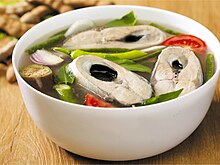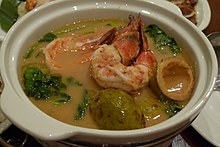 A bowl of tamarind sinigang A bowl of tamarind sinigang | |
| Type | Soup or stew |
|---|---|
| Course | Main course |
| Place of origin | Philippines |
| Region or state | Tagalog region |
| Serving temperature | Hot |
| Main ingredients | Meat, vegetables, tamarind, fish sauce, onions, siling mahaba, tomatoes |
| Variations | Pork, beef, shrimp, fish, chicken |
| Food energy (per serving) | ~120 kcal |
| Similar dishes | Pinangat na isda, paksiw, kansi, kadyos, baboy, kag langka |
| Other information | Can be served in many different forms |
Sinigang, sometimes anglicized as sour broth, is a Filipino soup or stew characterized by its sour and savory taste. It is most often associated with tamarind (Filipino: sampalok), although it can use other sour fruits and leaves as the souring agent such as unripe mangoes or rice vinegar. It is one of the more popular dishes in Filipino cuisine. This soup, like most Filipino dishes, is usually accompanied by rice.
Origin
Sinigang means "stewed "; it is nominalized in the form of the Tagalog verb sigang, "to stew". While present nationwide, sinigang is seen to be culturally Tagalog in origin, thus the similar sour stews and soups found in the Visayas and Mindanao (like linarang) are regarded as different dishes and differ in the ingredients used. Fish sauce is a common condiment for the stew.
Ingredients

Sinigang is most often associated with tamarind in modern times, but it originally referred to any meat or seafood cooked in a sour and acidic broth, similar to but differentiated from paksiw (which uses vinegar). Other variations of the dish derive their sourness from native ingredients. These souring agents include unripe mangoes, rice vinegar, butterfly tree leaves (alibangbang), citruses (including the native calamansi and biasong), santol, bilimbi (kamias or iba), gooseberry tree fruits (karmay), binukaw fruits (also batuan), and libas fruits, among others. Guava, introduced to the Philippines via the Manila galleons, is also used. Seasoning powder or bouillon cubes with a tamarind base are commercial alternatives to using natural fruits.
Sinigang typically uses meat or seafood (e.g., fish, pork, beef, shrimp, or chicken) stewed with tamarind, tomatoes, garlic, and onions. Other vegetables commonly used in the making of sinigang include okra, taro corms (gabi, which serves as a starchy broth thickener), white radish (labanós), water spinach (kangkóng), yardlong beans (sitaw) and eggplant (talóng). Most Filipinos like to cook sinigang with long green peppers (siling haba) to enhance the taste and add a little spice to the dish. Another variation includes adding locally made miso.
Sinigang variations



- Sinigáng na baboy - Pork Sinigang
- Sinigáng sa misô - Sinigang with miso added to the soup as the umami element, usually with a tamarind base
- Sinigáng sa bayabas - Sinigang that uses guava as the sour soup base
- Sinigang sa mangga - Sinigang that uses unripe mango as the sour soup base
- Sinigang sa kalamansi - Sinigang that uses calamansi or lemon as the sour soup base
- Sinigáng na isdâ - Fish sinigang
- Sinigang sa pakwan - Sinigang that uses watermelon together with tamarind as the sour soup base
- Sinigáng na hipon - Shrimp or prawn sinigang
- Sinigang na baka - Beef sinigang
- Seafood sinigang - Fish, shrimp, squid, seashells are combined in this soup
- Bule - A variant of sinigang from the Aeta people of Pampanga that uses lima beans (bule) and is soured with alibangbang (butterfly tree) leaves. Formerly called as bule baluga, the dish is now known mostly as bule due to the controversial term baluga, a derogatory and racist word towards Aetas.
Similar dishes
Main articles: Sinampalukan, Pinangat na isda, and LinarangSinampalukang manók or sinampalukan is technically not a variation of sinigang, as the chicken has to be sautéed in ginger first instead of all the ingredients being placed simultaneously into the pot and brought to a boil. Sinampalukan is also distinguished by its use of shredded tamarind leaves, and is usually made together with ginger, onions, tomatoes, eggplant and other vegetables.
Other Filipino dishes that are similar to sinigang but distinct include pinangat na isda from Southern Luzon and linarang from Cebu. Both of which also use sour fruits but are restricted to fish or seafood and differ in the other ingredients used.
There are also similar soured beef stews. They include the cansi from the Western Visayas islands which use beef and breadfruit and is soured with batuan or bilimbi fruits. Because it resembles a cross between bulalo and sinigang it is sometimes known as sinigang na bulalo. Another soured beef stew is sinanglaw from Ilocos which is soured with bilimbi or tamarind, but is unique in that it also includes bitter ingredients like bitter gourd or bile, as is common in Ilocano cuisine.
Malaysia

Around the east coast of Peninsular Malaysia, particularly in the states of Kelantan and Terengganu, there is a dish called singgang that is considered a close relative of sinigang. The common ingredients found in singgang are lemongrass, galangal, garlic, chili and asam gelugur as a souring agent. Either budu or tempoyak would also sometimes be added to further flavourize the dish. Terengganu's singgang and Kelantan's singgang differ through an addition of turmeric into the former.
Meanwhile, on the west coast of Peninsular Malaysia, another dish that is thought to be similar to singgang is called pindang.
Awards
The TasteAtlas 2021 Awards named “Sinigang” the best soup. It bested the Romanian cuisine Ciorbă de fasole cu afumătură and shōyu ("soy sauce") ramen of Japan. TasteAtlas 2023 chose the dish as one of the Best Dishes in the World, defeating żurek, steak au poivre, and pho bo.
See also
- Cansi
- Canh chua
- Hot and sour soup
- Sayur asem
- Pindang
- Tom yum
- List of soups
- List of stews
- Filipino cuisine
References
- "sigang". Tagalog-Dictionary.com. Retrieved December 16, 2018.
- Pamaran, Maan D'Asis (October 12, 2016). "The Filipino-Spanish food connection". Philippine Daily Inquirer. Retrieved December 16, 2018.
- "The Souring Agents of Sinigang". Our Philippine Trees. September 25, 2009. Retrieved April 17, 2019.
- "Sinigang na Salmon at Bauhinia Filipino Cuisine". Flavours of Iloilo. Retrieved April 17, 2019.
- The Souring Agents of Sinigang
- Sinigang Recipe
- Sinigang na Baboy Recipe
- "Sinigang na Baboy". Kawaling Pinoy. January 27, 2013. Retrieved August 29, 2021.
- Sinigang na Hipon Recipe - Pinoy Recipe at Iba pa. Retrieved March 30, 2019
- Seafood Sinigang Recipe - Pinoy Recipe at Iba pa. Retrieved March 30, 2019
- "Bule". Steamy Bain Marie. February 23, 2006. Retrieved November 29, 2019.
- Daez, Mikael (November 3, 2013). "Saksi: Bule baluga, sinigang na pinasarap ng patani". Saksi (in English and Tagalog). GMA. Retrieved November 29, 2019.
- Manalo, Lalaine (August 14, 2013). "Sinampalukang Manok". Kawaling Pinoy. Retrieved April 13, 2019.
- "Sinampalukan Manok (Tamarind'd Chicken)". 80 Breakfasts. February 16, 2009. Retrieved April 13, 2019.
- "Pinangat na Isda Fish Poached in Kamias and Tomatoes". Filipino-food-recipes.com. Retrieved January 10, 2019.
- Belen, Jun (June 15, 2011). "How to Make Fish Pinangat (Fish Soured in Calamansi and Tomatoes)". Junblog. Retrieved January 10, 2019.
- Fenix, Michaela (2017). Country Cooking: Philippine Regional Cuisines. Anvil Publishing, Incorporated. ISBN 9789712730443.
- Reyes, Gladys (July 31, 2014). "Ilonggo Food: Bacolod Cansi Recipe". Experience Negros. Retrieved October 23, 2019.
- "Sinanglaw". Ang Sarap. March 6, 2012. Retrieved October 17, 2020.
- "NCCA's 'Sinigang versus Adobo' poll divides the nation". GMA News Online. May 18, 2016. Retrieved January 15, 2022.
- Reggie Aspiras (October 8, 2009). "'Sinigang' and 'asocena' aren't exclusive to Filipinos". Philippine Daily Inquirer. Retrieved January 17, 2022.
- ^ "Khasiat ikan singgang dari sudut saintifik yang sangat wow". sinarplus+ (in Malay). Retrieved January 15, 2022.
- ^ "Singgang Ikan Tongkol Terengganu, Lauk Lejen Kesukaan Ramai". rasa (in Malay). November 18, 2021. Retrieved January 15, 2022.
- Basco, Karl Cedrick (January 2022). "'Sinigang' is world's best soup in TasteAtlas Awards 2021". ABS-CBN News and Current Affairs. Retrieved July 26, 2024.
- "Sinigang is one of the Best Dishes in the World". Rappler. December 19, 2023. Retrieved July 26, 2024.
Further reading
- Eckhardt, Robyn and David Hagerman. (2007-02-15). Why Not Sinigang?. Retrieved 2010-08-02 from the EatingAsia food blog.
- Fernandez, Doreen. (1976). Why Sinigang?. In Gilda Cordero-Fernando. The Culinary Culture of the Philippines. Manila: Bancom Audiovision Corporation. pp. 24–29.
- Perez, Irene C. (2010-07-01). Why piping-hot ‘sinigang’ is the national dish. Philippine Daily Inquirer. Retrieved 2010-08-02.
| Philippine soups | |
|---|---|
| |
| Official | |||||||
|---|---|---|---|---|---|---|---|
| Unofficial | |||||||
| National heroes |
| ||||||

